Imperial Reserve Fountain Pen c. 1952-1954
by Jim Mamoulides, May 5, 2023
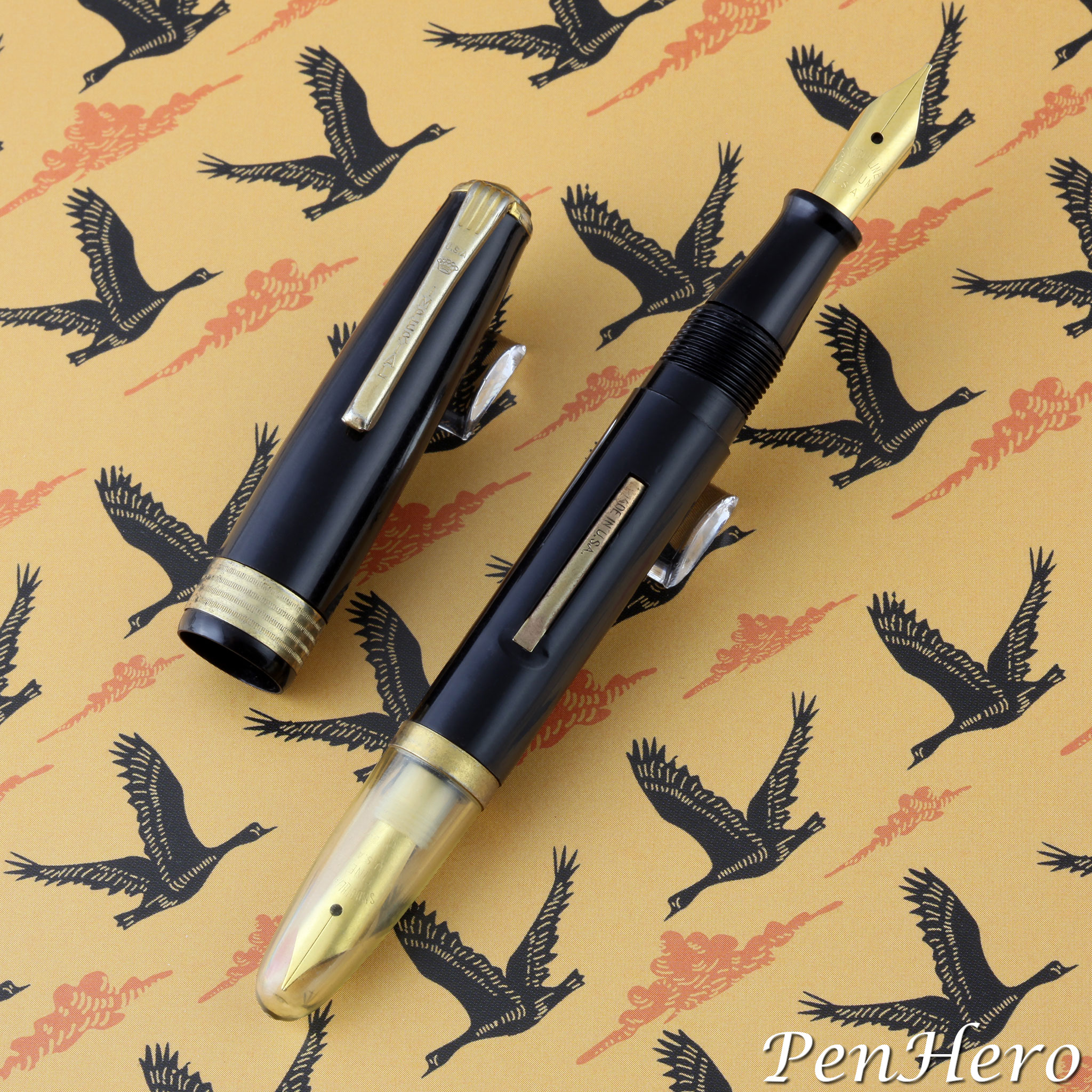 Imperial Reserve Fountain Pen black c. 1952-1954
Imperial Reserve Fountain Pen black c. 1952-1954
A Fair Day for a New Pen and Pencil Company
The earliest information I found on the Imperial Pen and Pencil Company of Nassau, New York is a listing for an Imperial fountain pen and pencil boxed set for $2.60 in a Harvey & Carey’s Drug Store advertisement in the Olean, New York Times Herald, on November 30, 1944. The next year, a short article in The Troy Record of Troy, New York on June 2, 1945, announces a change in the ownership structure of the Imperial Pen Company to a partnership including Frank, Betty and Ida Feldman of Nassau and also establishes the new name Imperial Pen and Pencil Company. Frank Feldman was probably the president of the company given he is identified as such in later documents and articles. With nothing earlier to go on my best guess is the company probably started in 1943 or 1944, giving some time to ramp up to where they could produce pens that retailers could sell.
The company probably first operated out of a building they built on or near the Nassau fairgrounds. As of January 2, 1945, Frank Feldman bought all the buildings and grounds of the Nassau Fair from the town of Nassau for $8,500. His intent was to expand or build additional factories as well as a housing project there after the end of World War II. Life must have been on the upswing for Frank Feldman as he married Selma Trachtenberg on May 23, 1947.
By 1948, the company had between 90 and 100 unionized workers, members of Local 938 of the Amalgamated Clothing and Textile Workers Union (ACTWU). On December 2, 1948, a fire destroyed the one-story brick factory building. Frank Aimes, company vice president, who at the time of the fire was reported as part owner of the factory, said, “the fire started when a workman pulled an overheated part of a pen from a machine and dropped it into a box of celluloid.” The box burst into flames and spread so rapidly that workers had to flee the building “without their personal belongings.” Volunteer fire companies from Nassau, West Schodack and Hoag’s Corners fought the fire for four hours. The factory building was only three years old and only partially insured. The employees volunteered to help rebuild the plant without pay in order to get back to work, according to Marion Percy, president of union Local 938 of the ACTWU.
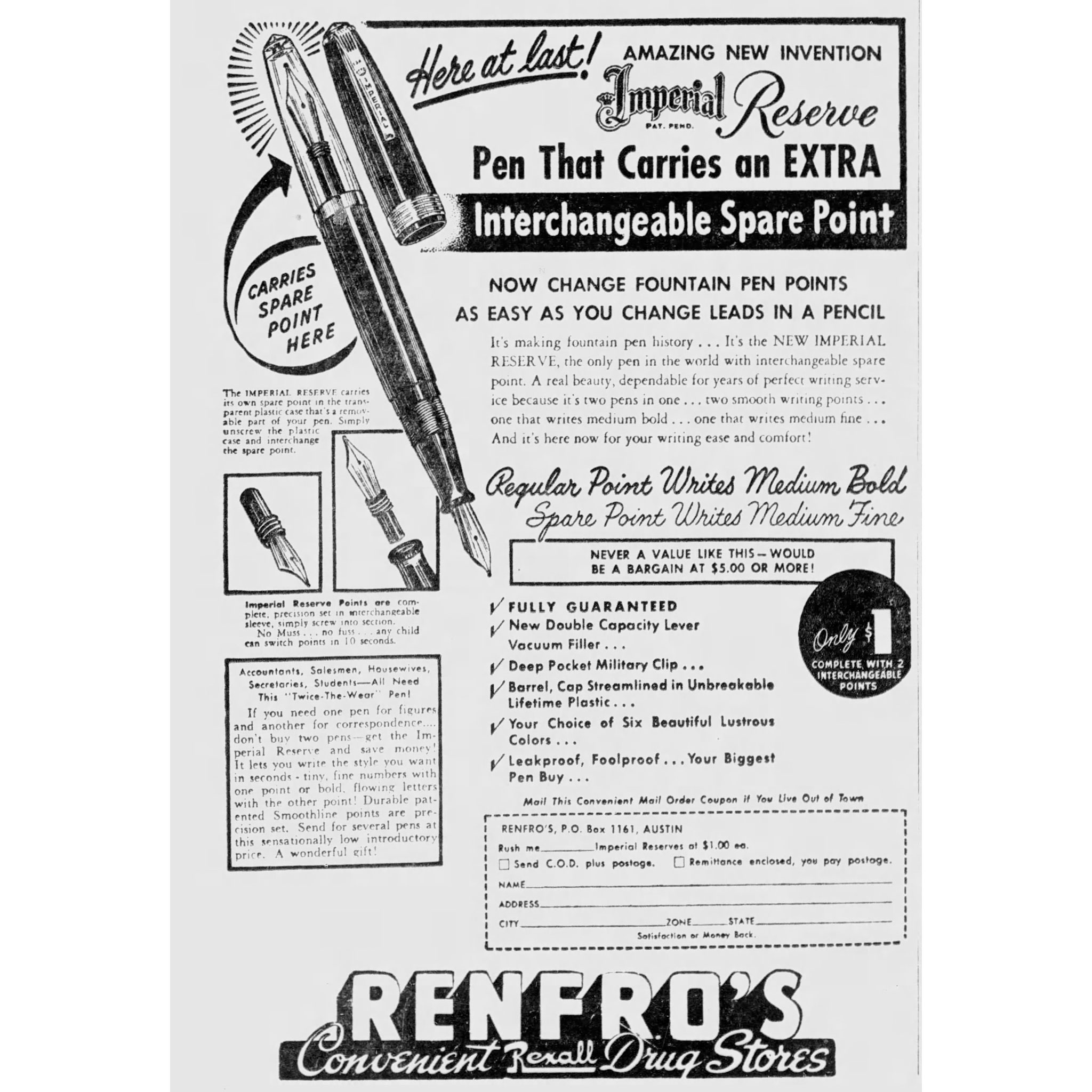 Advertisement, The Austin American, August 29, 1952
Advertisement, The Austin American, August 29, 1952
All This and Perfumed Ink!
The company made all sorts of writing instruments, including plastic and metal fountain pens, retractable ballpoint pens, mechanical pencils, 3 color ballpoint pens and fountain pen desk sets. The company had a sales office in New York City at 200 Fifth Avenue by 1949. A patent search shows only one patent assigned to the company, U. S. Patent 2,611,343, awarded September 23, 1952, to company vice president Francis M. Aimes of Nassau, N.Y. for a retractable pushbutton type of ballpoint pen. Aimes was apparently the in house inventor, awarded eighteen U. S. patents over his career before, during, and after working at Imperial, with eight related to pens and pencils, and five of those related to desk pen and/or pencil holders. The earliest was applied for on August 19, 1930, and granted May 24, 1932 and the latest granted April 12, 1966. His first pen related patent was for a pen display and demonstrating machine, U. S. Patent 2,095,851, granted October 12, 1937, and assigned to the Inkograph Company, Inc. of New York City, showing that he had experience in the writing instrument business prior to joining the Imperial Pen and Pencil Company.
The oddest thing the company made? How about a pen that writes with perfumed ink? Frank Feldman was interviewed as part of an April 17, 1953, United Press article on upcoming new products from several companies. He said that he believed girls should have a way to write “scented notes to their sweethearts” so the company would be making ballpoint pens with “rose-scented” ink. The ink cartridges would come in the same colors as standard ink, though the color is not specified. Were they already making pens for girls? Very likely as the company was awarded the trademark “BALLET,” filed June 18, 1947, though the company claimed use since April 1, 1947.
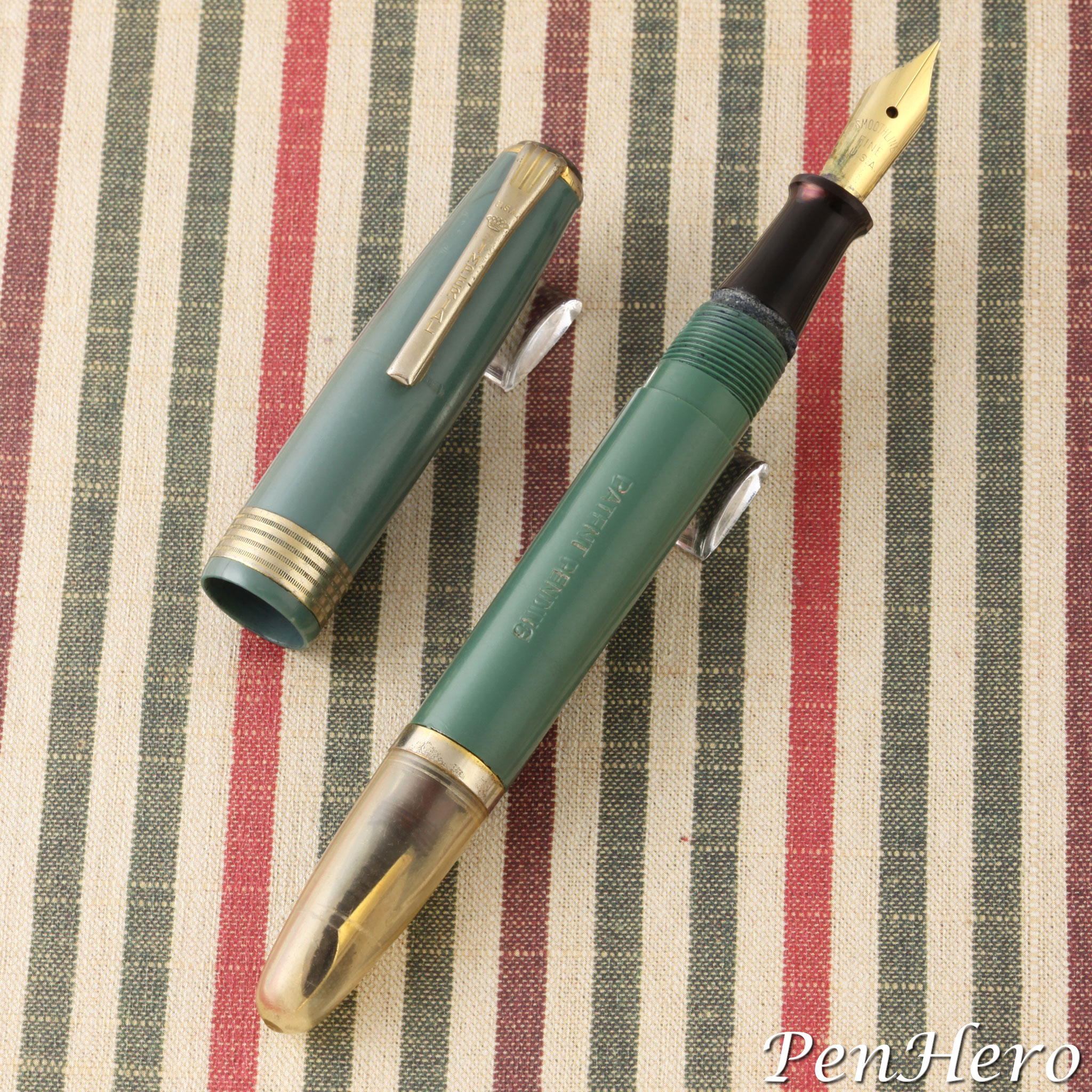 Imperial Reserve Fountain Pen green c. 1952-1954
Imperial Reserve Fountain Pen green c. 1952-1954
In spite of all this activity, the company evidently had ongoing financial difficulties, likely starting as a result of the costly 1948 fire. As of July 8, 1955, a tax lien of $25,219.62 was filed by the Internal Revenue Service against the company for excise and corporate income taxes for 1947 and 1952. Just over a year later, reported on September 7, 1956, the company filed for bankruptcy, with Frank Feldman listed as president and the only shareholder. At the time the company had assets of $97,867 and liabilities of $137,224. There was downstream impact to two other local pen companies. The Nassau Pen Manufacturing Company, named as a principal creditor and probably unrelated, having a different president, Hazel Bergerson, also declared bankruptcy, possibly triggered by Imperial’s woes. Spreading out the impact, another of the company’s largest creditors was the Mercury Pen Company of East Nassau. There were also tax and penalty claims of $17,268. As of September 13, 1957, the company still had an outstanding lien of $399 for withholding and excise taxes for 1956.
A Twofer That Any Child Can Switch in 10 Seconds!
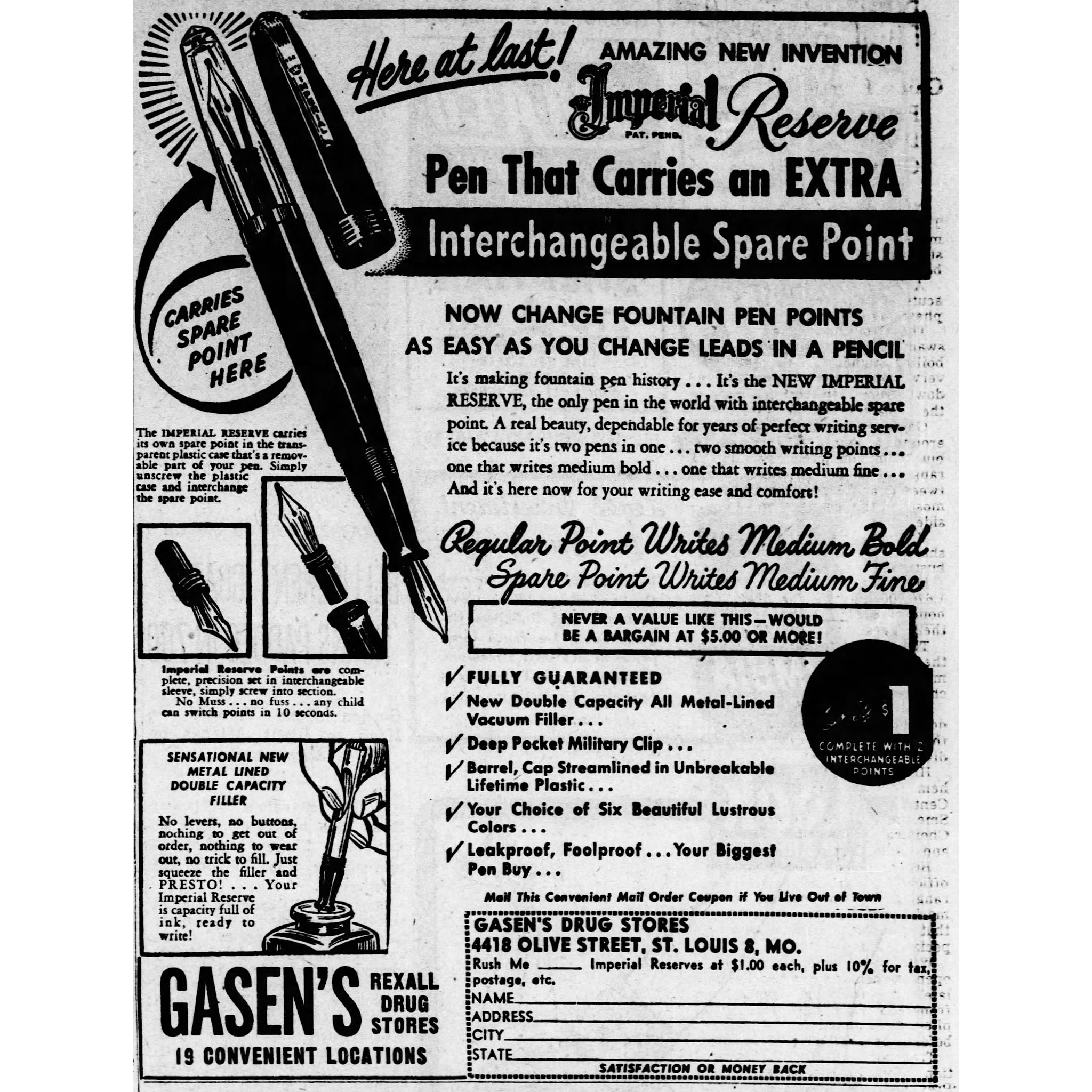 Advertisement, St Louis Post Dispatch, November 5, 1952
Advertisement, St Louis Post Dispatch, November 5, 1952
The earliest advertisement found for an Imperial Reserve fountain pen is a Ford Hopkins Rexall Drugs newspaper ad in the Winona Republican Herald dated June 4, 1952, offering the “dual point” Imperial Reserve fountain pen for one dollar, noting that the two points write medium bold and medium fine. The illustration has an arrow pointing to the spare nib unit in a clear dome cover on the end of the barrel. The spare point feature was described where “any child can switch points in 10 seconds.” These first pens are lever fillers. An ad in the New York Daily News dated June 16, 1952, shows the pen for 98 cents, and says they are available in blue, maroon and black. Just a few months later in what looks like company provided copy in the August 29, 1952, Austin American is an ad from Renfro’s Rexall Drug Stores offering the “bargain at $5.00 or more” Imperial Reserve pen in a choice of six colors, though which colors are not mentioned
A new development is announced in a newspaper ad from Gasen’s Rexall Drug Stores in the St Louis Post Dispatch dated November 5, 1952, describing the “Sensational new metal lined double capacity filler.” This is a press bar squeeze filler, a metal tube with a springy press bar that squeezes an ordinary ink sac. It’s made from stamped and shaped flat sheet metal and is similar to the ones used on Wearever pens. And with that switch to advanced ink filling technology, they still manage to sell them for only one dollar!
The pens may not have sold well as discounting has already started by May 1954. The last two known ads tell the story. A two for the price of one sale at 99 cents at Parke Drug Company of Asbury Park, NJ on May 10, 1954, and 79 cents in the Sun Store of Connellsville, Pennsylvania on September 16, 1954. After that date I could find no more advertisements and by September 7, 1956, the company was bankrupt.
Why only two points offered on these pens? We know from a mail order newspaper ad by a company called Glo Sales in Newark, NJ dated April 20, 1952, that fine, medium, and broad screw-in nib points were available on a different model Imperial fountain pen. Since it would make no sense to make two differently threaded nib units, I would expect these to also fit the Imperial Reserve pen. There’s no mention of broad points in any of the Imperial Reserve ads I reviewed. This does not mean they could not be acquired, but for the sake of simplicity for retailers, the pens were probably sold only with the two points. Not having any inserts or packaging for these pens I also don’t know if spare nibs and other points were offered direct from the company.
Patent Pending?
The pens are stamped PATENT PENDING on the barrel. A patent search under the company name shows only one patent, U. S. Patent 2,611,343, awarded September 23, 1952, to company vice president Francis M. Aimes of Nassau, N.Y. and assigned to the Imperial Pen & Pencil Company. It's a patent for a retractable pushbutton type of ballpoint pen, which is completely unrelated to this pen. Nothing found as to what they applied for but it’s likely about the spare nib unit feature as that is the selling point. Aimes has eighteen U. S. patents, eight related to pens and pencils, and five of those related to desk pen and/or pencil holders, with the earliest applied for on August 19, 1930, and granted May 24, 1932, and the latest granted April 12, 1966. His first pen related patent was for a pen display and demonstrating machine, U. S. Patent 2,095,851, granted October 12, 1937, and assigned to Inkograph Company, Inc. As Aimes was the most likely person to apply, no patents by him or assigned to the Imperial Pen & Pencil Company could be found that show this particular pen, design, or anything similar. I'm guessing it was applied for and not granted. Since the only novel feature is the spare nib at the end of the barrel, unless it was a design patent, in my opinion it's unlikely that feature was innovative enough for a technical patent.
Identification Guide and Features
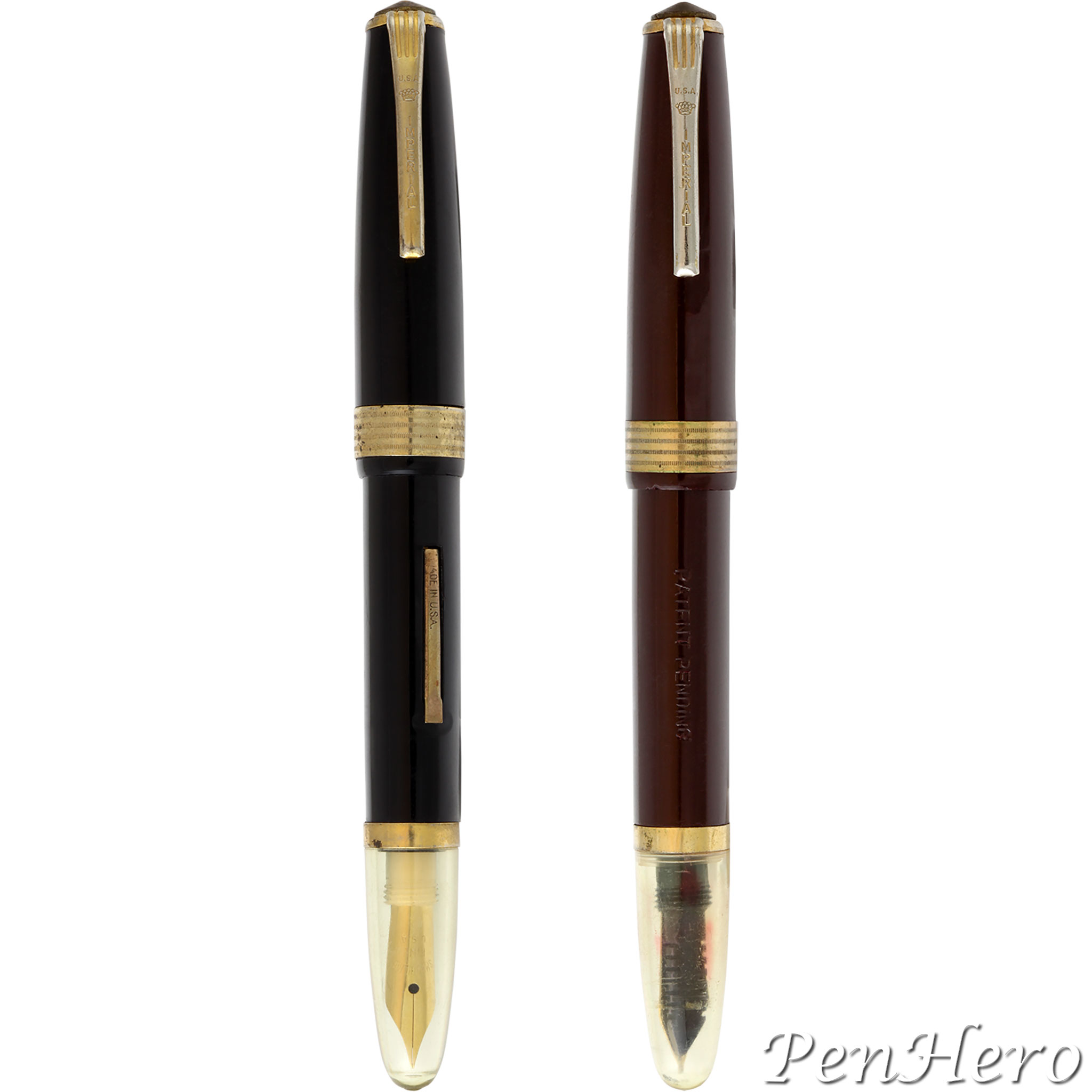 Imperial Reserve Fountain Pens in black and maroon c. 1952-1954
Imperial Reserve Fountain Pens in black and maroon c. 1952-1954
These fountain pens are about 5 3/8 inches long and came as either a lever filler, probably the first versions, or as a squeeze filler. The squeeze fill unit is a press bar type made from a metal tube that surrounds an ordinary ink sac and has a springy press bar attached. It’s made from stamped and shaped flat sheet metal. The spare nib is stored at the end of the barrel under a clear plastic end cap. The clip is stamped USA over a crown over IMPERIAL and the lever is stamped MADE IN U.S.A. The trim is lightly gold plated. The barrel is stamped PATENT PENDING. They sold for $1 and came in six colors, including black, brown, green, blue, and maroon. There is no information or existing pens that represent the sixth color, but Imperial also made pens in gray, so that is what I suspect is the final color. Interestingly the nib units are stamped MEDIUM or FINE, but advertised as "medium broad" and "medium fine." How they were packaged is unknown at this time.
- Cap, barrel, and nib section made from injection molded plastic in six solid colors including black, brown, green blue, and maroon
- Clip stamped USA over a crown over IMPERIAL down the face
- Spare nib stored at the end of the barrel under a clear plastic end cap
- Gold plated trim
- Gold plated stainless steel nib marked "SMOOTHLINE" over "[Nib width]" over "U.S.A."
- Nib has no tipping material - the ends of the tines are folded over
- Medium and fine point nibs
- Cap unscrews
- Lever filling system or squeeze filling system
- 5 3/8 inches long capped
- Retail price was $1.00
Performance
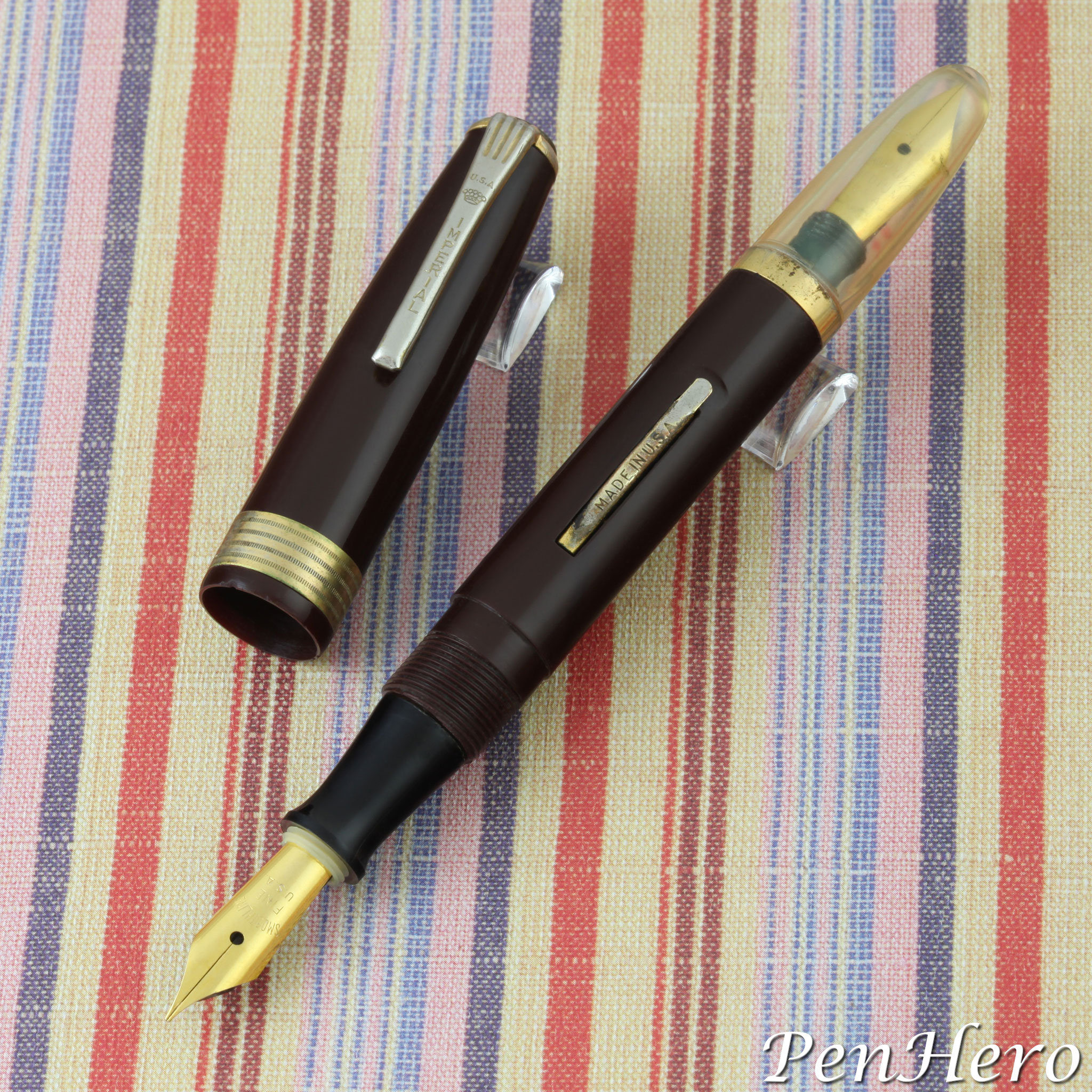 Imperial Reserve Fountain Pen maroon c. 1952-1954
Imperial Reserve Fountain Pen maroon c. 1952-1954
I only have examples of the lever fill version of the Imperial Reserve fountain pen. It has the look and feel of a large pen at 5 3/8 inches long. In spite of that, the ink sac inside is only effectively about 1 ¼ inches long, almost like a 1930s pen/pencil combo ink sac, because room has to be made in the back of the barrel for the second nib storage. You’ll be refilling this pen more frequently than an ordinary “one nib” pen. The parts all seem to fit together pretty well, but the gold plating is very light and looks like it would wear off very easily, as can be seen on the examples in this article.
It's a straightforward lever fill pen, you dunk the section in the ink, flip the lever, count to ten, wipe the section and nib, and write. The nib has folded tines instead of real tipping and my tester writes ok, but this type of nib will eventually wear down.
Overall, my impression is the Imperial Reserve fountain pen is quirky looking and interesting only because of the extra nib feature. Otherwise, it fits right in with any 1950s Wearevers you may have in your collection. Unlike Wearevers, these are difficult to find, likely because they did not sell well. When they do, they generally price higher that Wearever Pennants, but not by much. An interesting pen from a company that barely lasted a decade!
References
Advertisement, Daily News, April 20, 1952, page 68
Advertisement, Daily News, June 16, 1952, page 15
Advertisement, St Louis Post Dispatch, November 5, 1952, page 10C
Advertisement, The Austin American, August 29, 1952, page A-3
Advertisement, The Winona Republican Herald, June 4, 1952, page 9
Advertisement, Times Herald, Olean, NY November 30, 1944, Page 8
Amalgamated Clothing and Textile Workers Union (ACTWU), Hudson Valley Area Joint Board Records, 1919-1990, Undated
Bulletin of the Department of Labor of the State of New York, Issue 230, 1953, Page 89
Chain Store Age, Volume 25, Issues 7-12, 1949
Daily News, April 20, 1952, page 68
Directory of Manufacturers, Pens, Fountain, Chain Store Age, Volume 17, 1941. Page 68
Dunkirk Evening Observer, December 3, 1948, page 1
“Fire Burns Pencil Plant” Democrat and Chronicle, December 3, 1948, page 21
“Fire Destroys Pen Factory” The Ithaca Journal, December 2, 1948, page 1
“Fire Destroys Plant Near Nassau” Poughkeepsie Journal, December 2, 1948, page 34
“Nassau Fair Folds” The Bennington Evening Banner January 2, 1945, Page 2
“Newark, N.J., Girl Is Bride Of Frank Feldman, Nassau” The Post-Star, June 6, 1947, Page 10
“Pencil Plant Burns” The Kingston Daily Freeman December 2, 1948, Page 14
“Reporter Tells Of Surprises On Daily Beat” by Elizabeth Toomey, The Odessa American, April 17, 1953, Page 2
“Six Federal Tax Liens Filed With Court” The Times Record, September 13, 1957, page 14
“Tax Lien Filed Against Company” The Times Record, July 8, 1955, page
The American Exporter, Volume 146, 1950, page 241
“Two Nassau Pen Companies File Bankruptcy Pleas” The Times Record, September 7, 1956, page 17
United States Patent 2611343
Interact
Comments on this article may be sent to the author, Jim Mamoulides


